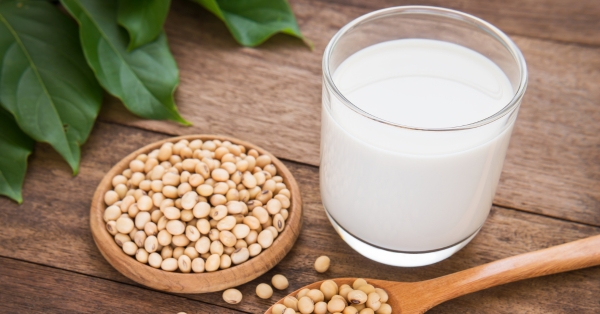Soy is one of the most nutritious plant-based proteins. It is free from cholesterol and contains all essential amino acids. With these properties, how can soy benefit us?
1. Cardiovascular Disease Prevention
Soy isoflavones have weak estrogenic effects that help lower low-density lipoprotein (“bad”) cholesterol and increase high-density lipoprotein (“good”) cholesterol, thereby promoting heart health. Soy saponins help lower cholesterol by increasing bile excretion.
The U.S. Food and Drug Administration (FDA) has concluded that 25 of soy protein a day, as part of a diet low in saturated fat and cholesterol may help to lower blood cholesterol levels, thereby lowering the risk or heart disease.
Research shows that an unhealthy diet high in sodium and low in potassium may lead to high blood pressure and atherosclerosis, both of which are main risk factors of stroke. Soy is rich in potassium, which helps the body to get rid of excess sodium, thus lowering the risk of stroke. Other research indicates that unsaturated fatty acids found in soybeans may help to cholesterol levels, prevent atherosclerosis, and decrease the accumulation of fats on arterial walls, thus helping to reduce the risk of stroke.
The high amounts of phytosterols in soy have the ability to lower cholesterol. Sitosterol makes up the largest proportion of phytosterols in soy (60%), followed by campesterol (20%) and stigmasterol (20%). Sitosterol has been used to treat hypercholesterolemia (very high levels of cholesterol in the blood). In addition, clinical studies have shown that phytosterol intake can reduce total cholesterol by 10% and LDL cholesterol by 15%.
Phytosterols can lower the body’s absorption of cholesterol. Research shows that consuming 1.5-1.8 g of phytosterols a day can reduce cholesterol absorption by 30%-40%, while an intake of 2.2 g of phytosterols per day can reduce cholesterol absorption by 60%, thereby lowering the risk of cardiovascular disease.

2. Diabetes Prevention
The glycemic index of soybean is 10-23, which is very low. It will cause only small fluctuations in blood glucose and insulin levels, helping to keep the blood sugar levels more stable. The glycemic index indicates the ability of carbohydrate-containing foods to raise blood glucose levels within two hours, on a scale of 0-100.
Diabetics are two to four times more likely to develop cardiovascular disease than people without diabetes. The American Diabetes Association recommends soy protein for diabetics. Research conducted in the UK showed how soy protein and soy isoflavones can aid in controlling blood sugar, helping postmenopausal women with type 2 diabetes become more sensitive to insulin, and reducing the risk of diabetes-related complications, such as heart disease and kidney damage.
In addition, soy is a good source of soluble fiber. Soluble fiber may help improve blood sugar control because it slows down the rate at which the body absorbs sugar.
3. Kidney Disease Prevention
Soy protein will not overburden the kidneys, hence reducing the risk of kidney damage. Studies have shown that soy protein is significantly better at aiding kidney function than animal protein.
Those with kidney disease must restrict their phosphorus intake. A result of damaged kidneys is hyperphosphatemia, or a high level of phosphate in the blood. This interferes with calcium balance in the body. Although soybeans contain large amounts of phosphorus, it is in the form of phytate, which is poorly absorbed.
4. Osteoporosis Prevention
Middle-aged and elderly women are at higher risk of osteoporosis due to declining estrogen levels. One main condition experienced by menopausal women in the U.S. is hip fracture caused by osteoporosis. The rate of hip fractures caused by osteoporosis in menopausal American women is nearly double that of Japanese women. Research has shown that this may be due to the latter’s regular consumption of soy foods.
Scientists discovered that soy isoflavones can help increase the absorption of calcium in the intestines, promote bone renewal in the lumbar spine, and minimize bone loss while enhancing bone cell growth. This, in turn, a enhances the body’s calcium absorption and increases bone density, helping to prevent osteoporosis and maintain bone health
5. Weight Management
People seeking to manage their weight will usually follow a low-calorie diet. Adequate protein intake is very important when on a low calorie diet because it helps prevent muscle loss. Muscle burns more calories than fat does. The more muscle a person has in relation to fat, the higher his or her metabolic rate will be. When on a low-calorie diet, not eating enough to build or maintain muscles will result in less muscle available to continue to burn calories. High in plant protein, soy is undoubtedly the ideal source of protein for people managing their weight.
Polypeptides and other compounds of soy also help weight loss in other ways. Scientists think that an active polypeptide in soy helps speed up the fat decomposition process. Experimental studies have shown that soy may aid weight loss by boosting metabolism. At the same time, soy peptides may interact with receptors in the brain to signal a feeling of satiety while delaying emptying of the stomach.
Moreover, the dietary fiber in soybeans allows one to feel full longer, which reduces the intake of other foods. Soy is also low in calories and fat.

6. Hormone Balance
Isoflavones and other phytoestrogens in soy can mimic the effects of the female hormone estrogen and help to prevent the body’s estrogen level from being too high or low, keeping it at a normal level.
Because of this effect, soy helps to improve complexion, alleviate menstrual discomfort, delay the onset of menopause and visible signs of aging, and may prevent diseases caused by hormonal imbalances, like breast, endometrial, and prostate cancers. For postmenopausal women, phytoestrogens in soy act like estrogens, thus relieving symptoms of menopause, such as hot flashes and increases in body temperature.
7. Brain Activity Enhancement
Phospholipids are crucial to brain health. Soy is rich in phospholipids, specifically lecithin, hence a diet high in soy contributes to better learning capabilities and helps to improve memory and vitality.
8. Blood Clot Prevention
Research has found that the soyasaponin in soy helps control blood platelets from lessening and thrombin, a key clot promoter, from forming, effectively preventing blood clots.
9. Complexion Improvement
Research shows that soybean paste contains linoleic acid, which helps suppress the formation of excess melanin, which is the main cause of pigmentation. At the same time, it helps promote softer, smoother, and fairer skin.

